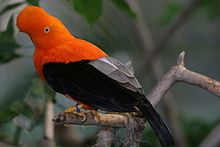Rupicola peruviana
| Andean cock-of-the-rock | |
|---|---|
 |
|
| Male (nominate) | |
 |
|
| Female (nominate) | |
| Scientific classification | |
| Kingdom: | Animalia |
| Phylum: | Chordata |
| Class: | Aves |
| Order: | Passeriformes |
| Family: | Cotingidae |
| Genus: | Rupicola |
| Species: | R. peruvianus |
| Binomial name | |
|
Rupicola peruvianus (Latham, 1790) |
|
| Subspecies | |
|
|
The Andean cock-of-the-rock (Rupicola peruvianus), also known as tunki (Quechua), is a large passerine bird of the cotinga family native to Andean cloud forests in South America. It is widely regarded as the national bird of Peru. It has four subspecies and its closest relative is the Guianan cock-of-the-rock.
The Andean cock-of-the-rock exhibits marked sexual dimorphism; the male has a large disk-like crest and scarlet or brilliant orange plumage, while the female is significantly darker and browner. Gatherings of males compete for breeding females with each male displaying its colourful plumage, bobbing and hopping, and making a variety of calls. After mating, the female makes a nest under a rocky overhang, incubates the eggs, and rears the young, all by herself.
The Andean cock-of-the-rock eats a diet of fruit, supplemented by insects, amphibians, reptiles, and smaller mice. It is distributed all across the cloud forest of the Andes, having a range of around 260,000 km2 (100,000 sq mi). Even though it is being affected by destruction of its habitat, the Andean cock-of-the-rock is not classified as threatened.
One of two species in the genus Rupicola, the other being the Guianan cock-of-the-rock, the Andean cock-of-the-rock was first described by English ornithologist John Latham in 1790. It is classified in the Cotingidae, a family of largely frugivorous tropical forest suboscine passerines. The generic name is derived from the Latin stems rupes "rock" or "cliff", and cola "inhabiting", and is derived from its habit of nesting in rock walls. Its specific epithet peruvianus "of Peru" is masculine despite the -a ending of the genus name (in Latin, names in -cola were masculine or neuter); peruviana is seen in older works.
Four subspecies are known:
...
Wikipedia

